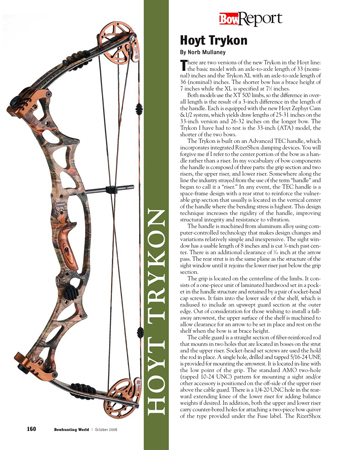Hoyt Trykon Bow Report
*Download the Bow Report*
 There are two versions of the new Trykon in the Hoyt line: the basic model with an axle-to-axle length of 33 (nominal) inches and the Trykon XL with an axle-to-axle length of 36 (nominal) inches. The shorter bow has a brace height of 7 inches while the XL is specified at 7 1//2 inches.
There are two versions of the new Trykon in the Hoyt line: the basic model with an axle-to-axle length of 33 (nominal) inches and the Trykon XL with an axle-to-axle length of 36 (nominal) inches. The shorter bow has a brace height of 7 inches while the XL is specified at 7 1//2 inches.
Both models use the XT 500 limbs, so the difference in overall length is the result of a 3-inch difference in the length of the handle. Each is equipped with the new Hoyt Zephyr Cam & 1/2 system, which yields draw lengths of 25-31 inches on the 33-inch version and 26-32 inches on the longer bow. The Trykon I have had to test is the 33-inch (ATA) model, the shorter of the two bows.
The Trykon is built on an Advanced TEC handle, which incorporates integrated RizerShox damping devices. You will forgive me if I refer to the center portion of the bow as a handle rather than a riser. In my vocabulary of bow components the handle is composed of three parts: the grip section and two risers, the upper riser, and lower riser. Somewhere along the line the industry strayed from the use of the term “handle” and began to call it a “riser.” In any event, the TEC handle is a space-frame design with a rear strut to reinforce the vulnerable grip section that usually is located in the vertical center of the handle where the bending stress is highest. This design technique increases the rigidity of the handle, improving structural integrity and resistance to vibration.
The handle is machined from aluminum alloy using computer-controlled technology that makes design changes and variations relatively simple and inexpensive. The sight window has a usable length of 8 inches and is cut 5/8-inch past center. There is an additional clearance of 1/16inch at the arrow pass. The rear strut is in the same plane as the structure of the sight window until it rejoins the lower riser just below the grip section.
The grip is located on the centerline of the limbs. It consists of a one-piece unit of laminated hardwood set in a pocket in the handle structure and retained by a pair of socket-head cap screws. It fairs into the lower side of the shelf, which is radiused to include an upswept guard section at the outer edge. Out of consideration for those wishing to install a fall-away arrowrest, the upper surface of the shelf is machined to allow clearance for an arrow to be set in place and rest on the shelf when the bow is at brace height. *Read the rest of the report by downloading the PDF






